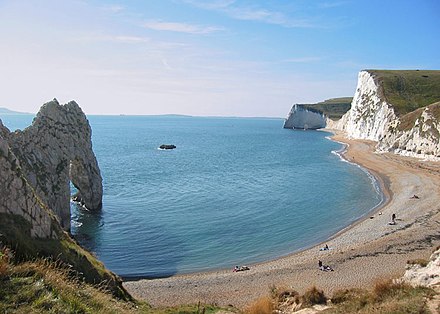Jurassic Coast - World Heritage Site in England
The Jurassic Coast is the popular (and now official) name given to a 95 mile (155 km) long stretch of coastline in southern England, incorporating parts of the east Devon and Dorset coasts.
The Jurassic Coast was inscribed as a World Heritage site in 2001 on account of its importance to geology and palaeontology, and the sheer beauty of its landscape. UNESCO lists it as Dorset and East Devon Coast. The area attracts hundreds of thousands of fossil hunters, hikers, campers and beach-goers each year.
Towns
- Burton Bradstock — village in West Dorset near West Bay
- Lulworth
- Lyme Regis
- Weymouth
- West Bay
Other destinations
Understand
Many of the earliest recognised scientific dinosaur discoveries were made along the Jurassic Coast in the early 19th century, promoting the rise of the science of paleontology. Pioneering fossil hunters like Mary Anning took advantage of the coast's highly fossiliferous cliffs.
Get in
There is a South Western Railways service from London Waterloo to Poole and Exeter.
Get around
These bus services are of particular use to people visiting the Jurassic Coast:
The X53/X51 (dead link: January 2023) bus service from Axminster to Weymouth/Dorchester via Lyme Regis, Charmouth, Bridport, West Bay.
The 885 bus service from Axminster to Beer via Colyton and Seaton.
The 899 bus service from Seaton to Sidmouth via Beer and Branscombe. This bus route is very picturesque as it winds its way down the charming Devon lanes.
The X54 (dead link: January 2023) bus service from Weymouth to Poole via Wearham.
The 40 bus service from Swanage to Poole via Corfe Castle and Wearham.
See
The attractions of the Jurassic Coast are many. Not to be missed, however, are:

- Lulworth Cove at Lulworth
- Durdle Door, within easy hiking / kayaking distance west of Lulworth
- Chesil Beach, the longest example of a tombolo (sandy isthmus) in the UK
- Golden Cap near Charmouth, the highest point on the south coast of Britain at 191 metres (627 ft).
Do
Eat
- Being on the coast, fresh fish & chips is widely available.
Drink
Stay safe
Cliffs can be prone to rockfalls, so avoid walking directly beneath them. This is not an abstract risk: people are killed this way with regrettable frequency.
Go next
Related: UNESCO World Heritage List
Jurassic Coast
jurassiccoast.comDorset
2nd-order administrative division
England
Primary administrative division